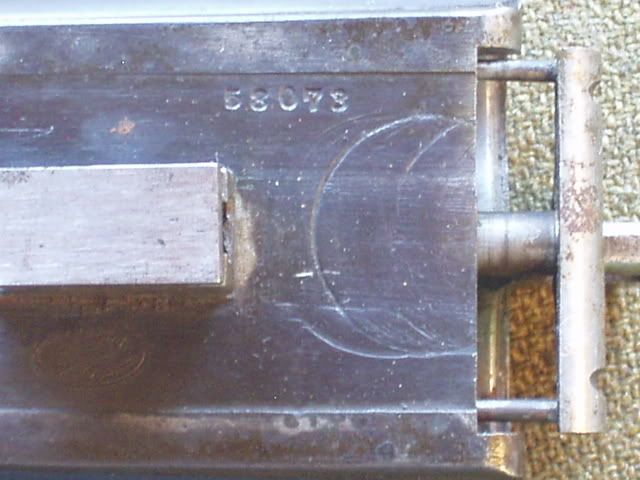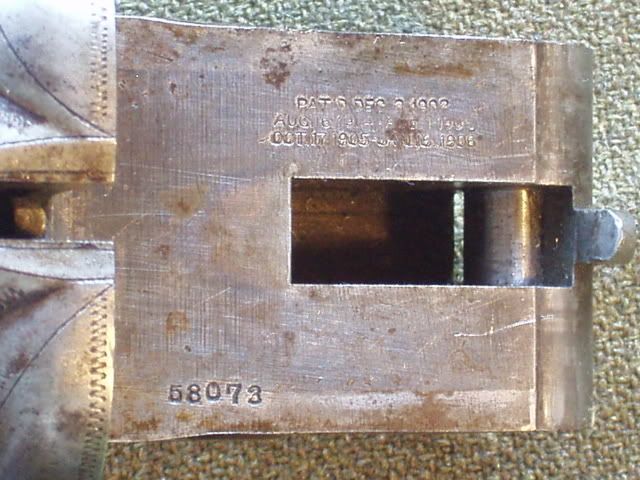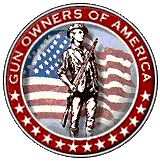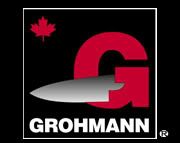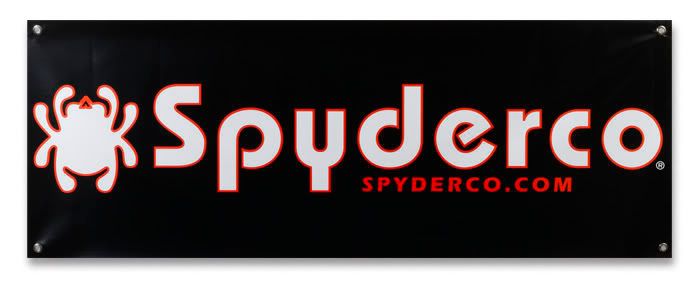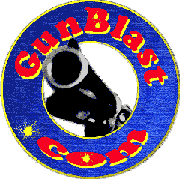Well, I got home from work yesterday to find an ongoing drama involving a young man who'd escaped from police custody during one of those traffic stops gone complicated. To summarize my impressions from Mrs. Hobie's excited telling of the tale...
Apparently, the Staunton PD made a traffic stop and discovered some marijuana in the car. They went to arrest the two occupants and the passenger twisted away from the officer and ran right down the street over my back fence and through my backyard past my wife and into the front yard. He then doubled back and hid on my front porch as the cops went into the park across the street looking for him. All the neighbors were out but the one on that side of the house saw him crouching on the front porch behind a rocking chair and thought we'd hired painters! Jeez. Anyway, the other neighbors and my wife were also looking but didn't see him up there. He then hopped the railing into my garden and ran back through the backyard, back over the fence and up the street stopping to hide under a trailer where another person saw him but didn't report him.
Meanwhile, my wife found a cartridge he'd dropped on the front porch (which the police took as evidence) leading to speculation that he'd had a gun to go with that cartridge but we've not found the gun (by "we" I mean both us and the police).
Now, this fellow is known by name to the cops and of course his friend/the driver dropped the dime on him. It appears that he knew the penalty for drugs+gun and that is why he ran. Worse yet (?) he's a local high school football player.
This is the third incident we've had in our yard or the street in front of the house in two years. The first was a young (?) man peeping (?) looking for entry and the second was the drive-by shooting (actually shooting into the park but while driving in front of the house). I don't like how this is going. This is not the community it was 20 years ago when we moved here.
Saturday, March 31, 2007
Friday, March 30, 2007
I Couldn't Help Myself
No, I couldn't help myself. I've been wanting to have an example of the Ruger Bearcats but really preferred getting one of the older guns. Yesterday, I happened to walk in on Nuckoll's Gun Works and they had one, serial B2XX! Not great condition. There is considerable blue wear to the left of the barrel and a couple of scratches. But, there is no rust, no dings in the trigger guard, no chips or dents in the stocks. I got it for $245. I'll amend this post with photos as soon as I can get the gun in front of a camera.
 This first year gun may not be in the best of condition but it is a treat. There is something to be said for Bill Ruger's marketing savvy. When I was a kid and saw one of these on display it was certain to elicit drooling and nose prints on the display case glass. When I actually got to shoot one I was old enough that I'd come near to completing my physical growth and didn't get to enjoy the tiny revolver for what it is for young people, a revolver scaled to work for young people. Oh, it is a joy for us older and/or larger folks but for kids, what joy it must have been. I just know the grandkids will love this little gun.
This first year gun may not be in the best of condition but it is a treat. There is something to be said for Bill Ruger's marketing savvy. When I was a kid and saw one of these on display it was certain to elicit drooling and nose prints on the display case glass. When I actually got to shoot one I was old enough that I'd come near to completing my physical growth and didn't get to enjoy the tiny revolver for what it is for young people, a revolver scaled to work for young people. Oh, it is a joy for us older and/or larger folks but for kids, what joy it must have been. I just know the grandkids will love this little gun.
William B. Ruger, in an interview with James Bequette, said of the Bearcat,

Links:
- Steve Fjestad the author and publisher of The Blue Book of Gun Values discusses the value of a Ruger Bearcat revolver.
- True Blue Sam the Travelin' Man: Working On Your Ruger Bearcat
 This first year gun may not be in the best of condition but it is a treat. There is something to be said for Bill Ruger's marketing savvy. When I was a kid and saw one of these on display it was certain to elicit drooling and nose prints on the display case glass. When I actually got to shoot one I was old enough that I'd come near to completing my physical growth and didn't get to enjoy the tiny revolver for what it is for young people, a revolver scaled to work for young people. Oh, it is a joy for us older and/or larger folks but for kids, what joy it must have been. I just know the grandkids will love this little gun.
This first year gun may not be in the best of condition but it is a treat. There is something to be said for Bill Ruger's marketing savvy. When I was a kid and saw one of these on display it was certain to elicit drooling and nose prints on the display case glass. When I actually got to shoot one I was old enough that I'd come near to completing my physical growth and didn't get to enjoy the tiny revolver for what it is for young people, a revolver scaled to work for young people. Oh, it is a joy for us older and/or larger folks but for kids, what joy it must have been. I just know the grandkids will love this little gun.William B. Ruger, in an interview with James Bequette, said of the Bearcat,
"Always admired Remington’s percussion revolvers. They felt better to me than the Colts. The Bearcat was obviously developed after the Remington design. It was a smaller version than the Remington Army. More like the Police revolver. We used some radical ideas, having an aluminum frame for example, to produce it more efficiently."I understand that there are quite a number of variations of the old model, 1958 to 1970, the Super Bearcat, from 1971, and new model, 1993 and later, that a complete collection of Bearcats requires one to obtain well over 40 guns.

Links:
- Steve Fjestad the author and publisher of The Blue Book of Gun Values discusses the value of a Ruger Bearcat revolver.
- True Blue Sam the Travelin' Man: Working On Your Ruger Bearcat
Thursday, March 29, 2007
Winchester 101s - Dad's Skeet Guns

My dad was an outdoorsman, forester, minor league baseball player, soldier (combat engineer and infantryman 1945-47 and 1950-1951 respectively, thanks Dad), pilot (one solo flight) and skeet shooter. He apparently started skeet shooting when he returned home from his first two years in service and was awaiting admission to Syracuse University. He apparently shot a lot of skeet, what is now international style, before departing for university and did so with an old Savage or Stevens made Tru-Test 16 ga. side by side (I have that gun, too). Choked modified and full and missing the front bead even then, this second hand shotgun was likely the best he could find and afford at the time. I've no idea how he got the shells or paid for the many rounds of skeet that he shot.
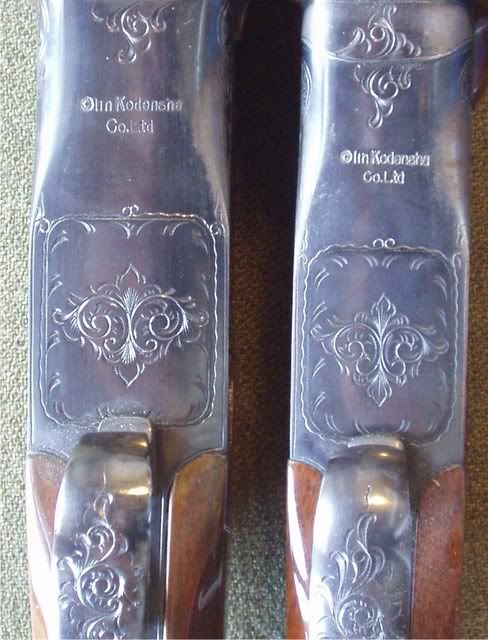 He must have been popular because when we went to that range when I was about 12-13 that must have been 20 years after he'd last been shooting there and several of the old guys (to me!) recognized him and came up to shake his hand. That single visit to that range rekindled his interest and we were shortly looking for places to shoot. Dad tried a couple of used Winchester 1400s but wasn't happy with them. I know it took a lot of cleaning on my part to keep them going (not that I minded). At some point he decided that this pair of 101s were the deal and he dropped his credit card and the two 1400s on Jon Ridenour's counter and walked out with them both. He must have been enamoured of these guns because he never, ever used the credit card for anything but emergencies.
He must have been popular because when we went to that range when I was about 12-13 that must have been 20 years after he'd last been shooting there and several of the old guys (to me!) recognized him and came up to shake his hand. That single visit to that range rekindled his interest and we were shortly looking for places to shoot. Dad tried a couple of used Winchester 1400s but wasn't happy with them. I know it took a lot of cleaning on my part to keep them going (not that I minded). At some point he decided that this pair of 101s were the deal and he dropped his credit card and the two 1400s on Jon Ridenour's counter and walked out with them both. He must have been enamoured of these guns because he never, ever used the credit card for anything but emergencies.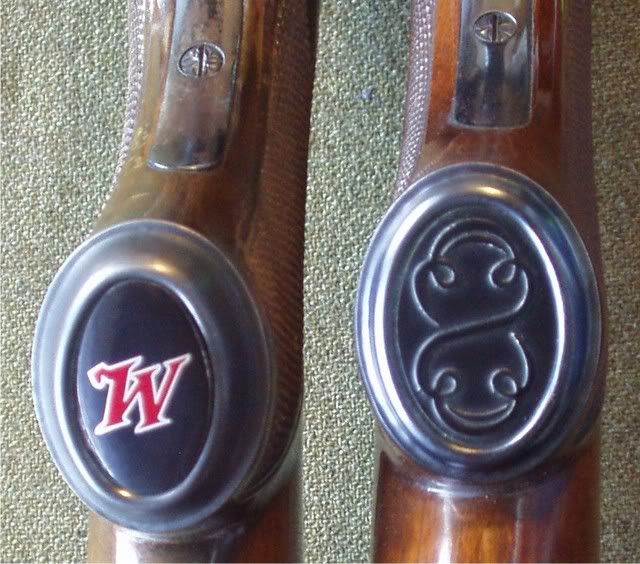 The Winchester Model 101 Over-Under shotguns were introduced in 1963. Dad's 101s are skeet guns in 12 and 20 gauge (bottom) but the skeet guns were made in all four skeet gauges, 12, 20, 28 and .410 (I know, not a gauge but a "bore"). They are over-under double guns, with barrels mesuring 26-1/2" on the 20 and 26" even on the 12 gauge with ventilated ribs, barrel selector switch safeties and single triggers. The old Winchester 101 was something of a landmark gun in the post-war history of the shotgun, one of the models that firmly established the over-and-under as the gun for competition clay shooting. Based on the Browning B25, it handled well, was affordable and was well built by the Japanese. Thousands were sold. Dad must have really liked his as he never considered selling them even after his macular degeneration ended all his shooting.
The Winchester Model 101 Over-Under shotguns were introduced in 1963. Dad's 101s are skeet guns in 12 and 20 gauge (bottom) but the skeet guns were made in all four skeet gauges, 12, 20, 28 and .410 (I know, not a gauge but a "bore"). They are over-under double guns, with barrels mesuring 26-1/2" on the 20 and 26" even on the 12 gauge with ventilated ribs, barrel selector switch safeties and single triggers. The old Winchester 101 was something of a landmark gun in the post-war history of the shotgun, one of the models that firmly established the over-and-under as the gun for competition clay shooting. Based on the Browning B25, it handled well, was affordable and was well built by the Japanese. Thousands were sold. Dad must have really liked his as he never considered selling them even after his macular degeneration ended all his shooting. Our guns have few differences despite the 5 years between manufacture of the two guns. The 12 ga. has the big red W on the pistol grip cap, while the 20 ga. has the plainer cap shown. Together with the barrel length, these are the major differences between these guns made at the Olin Kodensha plant in Japan in 1970 (20) and 1965 (12).
Links:
- Midwest Gun Works 101 Serials
Wednesday, March 28, 2007
Yet More, Knives, Knives, Knives....
No I haven't run out of knives yet. Sorry about that!
 Long knives fascinate most of us. If you need proof of that look at the humongous honkin' big knives that pay the bills for so many knife companies. They are all over the place. Well a machete is just another knife, but a long bladed one and with some utility to boot. I bought this Collins machete from Mrs. Kramer's antique store in Bridgewater, VA around about 1967-69. I'm not quite sure of the date, but it was in the spring as I was happy to get outside and use Dad's leather tools and thread to repair the scabbard. No, I couldn't repair where some previous user had dragged the sharp blade through the throat of the scabbard neatly cutting it about 2" deep. What I could do was to lock stitch the back of the scabbard and to clean it with saddle soap so that it could survive to today. Dad thought but didn't say out loud that I was crazy to pay $10 for it. He was right. $10 is about what one pays for a machete today! In 1969 that was a lot of money.
Long knives fascinate most of us. If you need proof of that look at the humongous honkin' big knives that pay the bills for so many knife companies. They are all over the place. Well a machete is just another knife, but a long bladed one and with some utility to boot. I bought this Collins machete from Mrs. Kramer's antique store in Bridgewater, VA around about 1967-69. I'm not quite sure of the date, but it was in the spring as I was happy to get outside and use Dad's leather tools and thread to repair the scabbard. No, I couldn't repair where some previous user had dragged the sharp blade through the throat of the scabbard neatly cutting it about 2" deep. What I could do was to lock stitch the back of the scabbard and to clean it with saddle soap so that it could survive to today. Dad thought but didn't say out loud that I was crazy to pay $10 for it. He was right. $10 is about what one pays for a machete today! In 1969 that was a lot of money.
I've used this machete which is of much better quality than many of today's manufacture and with a neatly tooled scabbard to boot, and I've used it a lot. Still, it is in good condition. In many ways this is like a short sword and indeed there are still some who would use it as such. In any case the steel is of good quality easily taking an edge but holding that edge for a reasonable period.
I seldom use it anymore though. Mostly I use either an Army issue type or a Woodsman's Pal for such tasks. I'd rather preserve this old friend for another day. It is seldom enough that one finds a blade of this quality in this condition to waste in on vines and fence rows.
The Collins Company has a long and storied history so much so that a book was written on the subject, Collins Machetes and Bowies: 1845 - 1965, by Daniel Edward Henry which, because it is out of print, now sells for more than $95 a copy!
Next is a current, standard issue US Army machete. The 18" blade is about 1/8" thick and the handle is of plastic as is the sheath. Included on the sheath is a an integral sharpener. I've used this particular machete for about 15 years. These things are hell for stout and I've never seen one broken, yet. Mine was made by Ontario and is used as you can tell by the grime on the blade. This thing is great for reaching where the Woodman's Pal can't so that you can avoid spines and stickers. I don't care how tough you might think you are spines and stickers can be really irritating so why put up with such if you don't have to!
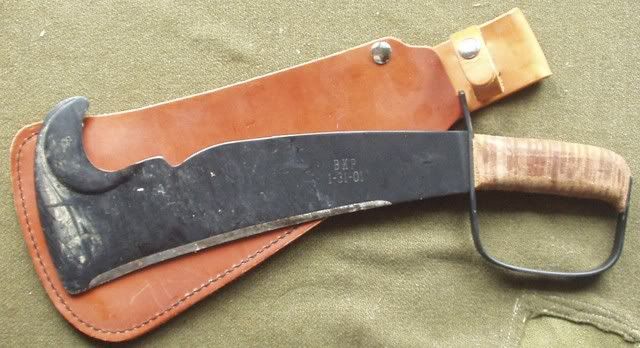 The Woodman's Pal is generally the finest general purpose "machete" out there. From their site is this short history of the tool:
The Woodman's Pal is generally the finest general purpose "machete" out there. From their site is this short history of the tool:
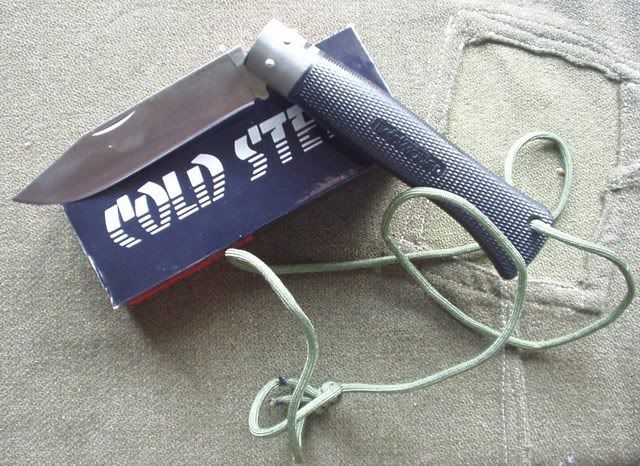 Cold Steel makes some great knives. However, finding knives that are legal for carry here in Virginia is a royal pain. As a CHP holder I don't want to get permanently zapped for something really stupid, like Senator Webb and his aide Phillip Thompson, so I take care to legally carry guns and knives. One of those was the smaller version of the Twistmaster knife which you've seen in my post about my hunting bag which is where it resides. At the time I also bought this larger version which I've never carried! I guess it is a collector's item now. The blades are made of Cold Steel's Carbon V and are wicked sharp out of the box. The edge isn't difficult to maintain and the fiberglass reinforced handles are both stronger than the Opinel which they mimic but also easier to hold due to their shape and to hold on to due to the sharp, molded checkering.
Cold Steel makes some great knives. However, finding knives that are legal for carry here in Virginia is a royal pain. As a CHP holder I don't want to get permanently zapped for something really stupid, like Senator Webb and his aide Phillip Thompson, so I take care to legally carry guns and knives. One of those was the smaller version of the Twistmaster knife which you've seen in my post about my hunting bag which is where it resides. At the time I also bought this larger version which I've never carried! I guess it is a collector's item now. The blades are made of Cold Steel's Carbon V and are wicked sharp out of the box. The edge isn't difficult to maintain and the fiberglass reinforced handles are both stronger than the Opinel which they mimic but also easier to hold due to their shape and to hold on to due to the sharp, molded checkering.
 This next knife was recommended by Mike Nesbitt of Muzzleloader Mag (and others) in his monthly column. Clearly, I'm easily influenced and quickly ordered the knife. marked John Nowill & Sons LTD, Sheffield, this knife is an old pattern and well executed by the manufacturer. The rivets are neat and the handle tight to the tang. Despite the low cost, this is a quality knife. However my sheath is about 2-3 inches too short. Commercially made, I've not taken the time to replace it. I've not used the knife though. Perferring to wait to carry it until I have a proper sheath.
This next knife was recommended by Mike Nesbitt of Muzzleloader Mag (and others) in his monthly column. Clearly, I'm easily influenced and quickly ordered the knife. marked John Nowill & Sons LTD, Sheffield, this knife is an old pattern and well executed by the manufacturer. The rivets are neat and the handle tight to the tang. Despite the low cost, this is a quality knife. However my sheath is about 2-3 inches too short. Commercially made, I've not taken the time to replace it. I've not used the knife though. Perferring to wait to carry it until I have a proper sheath.
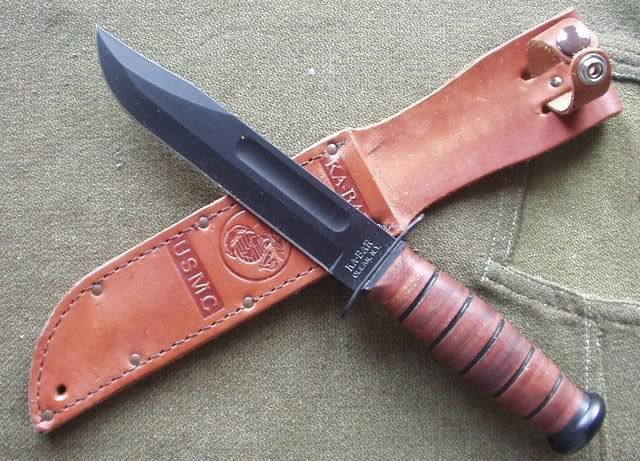 The next knife is the very common and widely well regarded Kabar or Marine Corps knife. This blade shape has been in use for a long time and the knife pattern is very popular for good reasons. It is versatile and useful for both camp duties and self defense. The maker executes manfacturer well, maintaining consistently high quality and reasonable price. Mine came from my son but I've never used it. The USMC sheath embossing isn't necessarily my taste but that hardly disqualifies the knife from an honored place.
The next knife is the very common and widely well regarded Kabar or Marine Corps knife. This blade shape has been in use for a long time and the knife pattern is very popular for good reasons. It is versatile and useful for both camp duties and self defense. The maker executes manfacturer well, maintaining consistently high quality and reasonable price. Mine came from my son but I've never used it. The USMC sheath embossing isn't necessarily my taste but that hardly disqualifies the knife from an honored place.
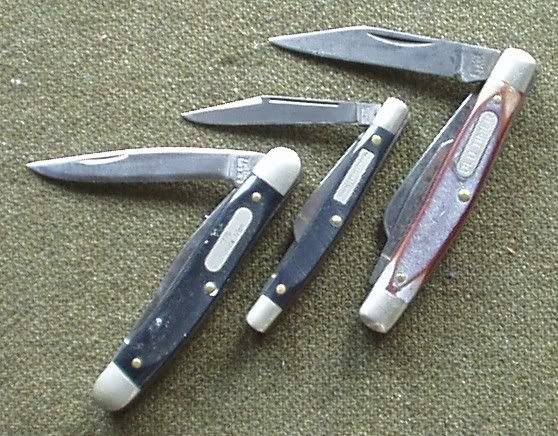 These last knives (for now) are these three pocket knives. All are of common form and equally useful despite their different sizes. Despite or because of their small size, they are eminently useful daily carry knives. These have opened many a package, clipped threads, and generally served as pocket knives serve and done so well. The maker is unimportant but these knives by Schrade, Buck and from Sears (I don't know who their vendor is) are all fine knives.
These last knives (for now) are these three pocket knives. All are of common form and equally useful despite their different sizes. Despite or because of their small size, they are eminently useful daily carry knives. These have opened many a package, clipped threads, and generally served as pocket knives serve and done so well. The maker is unimportant but these knives by Schrade, Buck and from Sears (I don't know who their vendor is) are all fine knives.
I have lots of knives, as you've seen, but I've not told you about the multitools. That is for another time...
 Long knives fascinate most of us. If you need proof of that look at the humongous honkin' big knives that pay the bills for so many knife companies. They are all over the place. Well a machete is just another knife, but a long bladed one and with some utility to boot. I bought this Collins machete from Mrs. Kramer's antique store in Bridgewater, VA around about 1967-69. I'm not quite sure of the date, but it was in the spring as I was happy to get outside and use Dad's leather tools and thread to repair the scabbard. No, I couldn't repair where some previous user had dragged the sharp blade through the throat of the scabbard neatly cutting it about 2" deep. What I could do was to lock stitch the back of the scabbard and to clean it with saddle soap so that it could survive to today. Dad thought but didn't say out loud that I was crazy to pay $10 for it. He was right. $10 is about what one pays for a machete today! In 1969 that was a lot of money.
Long knives fascinate most of us. If you need proof of that look at the humongous honkin' big knives that pay the bills for so many knife companies. They are all over the place. Well a machete is just another knife, but a long bladed one and with some utility to boot. I bought this Collins machete from Mrs. Kramer's antique store in Bridgewater, VA around about 1967-69. I'm not quite sure of the date, but it was in the spring as I was happy to get outside and use Dad's leather tools and thread to repair the scabbard. No, I couldn't repair where some previous user had dragged the sharp blade through the throat of the scabbard neatly cutting it about 2" deep. What I could do was to lock stitch the back of the scabbard and to clean it with saddle soap so that it could survive to today. Dad thought but didn't say out loud that I was crazy to pay $10 for it. He was right. $10 is about what one pays for a machete today! In 1969 that was a lot of money.I've used this machete which is of much better quality than many of today's manufacture and with a neatly tooled scabbard to boot, and I've used it a lot. Still, it is in good condition. In many ways this is like a short sword and indeed there are still some who would use it as such. In any case the steel is of good quality easily taking an edge but holding that edge for a reasonable period.
I seldom use it anymore though. Mostly I use either an Army issue type or a Woodsman's Pal for such tasks. I'd rather preserve this old friend for another day. It is seldom enough that one finds a blade of this quality in this condition to waste in on vines and fence rows.
The Collins Company has a long and storied history so much so that a book was written on the subject, Collins Machetes and Bowies: 1845 - 1965, by Daniel Edward Henry which, because it is out of print, now sells for more than $95 a copy!
Next is a current, standard issue US Army machete. The 18" blade is about 1/8" thick and the handle is of plastic as is the sheath. Included on the sheath is a an integral sharpener. I've used this particular machete for about 15 years. These things are hell for stout and I've never seen one broken, yet. Mine was made by Ontario and is used as you can tell by the grime on the blade. This thing is great for reaching where the Woodman's Pal can't so that you can avoid spines and stickers. I don't care how tough you might think you are spines and stickers can be really irritating so why put up with such if you don't have to!
 The Woodman's Pal is generally the finest general purpose "machete" out there. From their site is this short history of the tool:
The Woodman's Pal is generally the finest general purpose "machete" out there. From their site is this short history of the tool: The History of the Woodman's Pal®The Woodman's Pal is probably the best tool for clearing wire fence lines as the it is realtively easy to keep the edges from striking the metal wire. This keeps the working edges sharp longer making for easier, more efficient work. Anything to cut my time doing chores, well I'm all for that. As you can see I actually use mine!
Frederick Ehrsam was not only an expert on edge tools used throughout the world. By the time he settled in Pennsylvania, in the 1930's, the Swiss National was also an experienced architect, artist, engineer, manufacturer, and woodsman.
Over the next ten years, all these skills would be used in the creation of a tool that would eventually influence modern forest and land management.
Professionals in the forest and field relied heavily on the machete for clearing brush and blazing trails. Other tools were also needed to thin, trim, chop, and prune.
Frederick Ehrsam saw the need for a single implement that could not only perform the task of each as well or better, but could eliminate drawbacks like awkward weight or bulk, lack of balance or versatility, and designs unsafe for the inexperienced user. In 1941, Frederick Ehrsam introduced the Woodman's Pal®. Professionals in forestry, agriculture, and horticulture quickly recognized it as a historic achievement.
This new tool did not go unnoticed by the US Military. The Woodman's Pal® or "LC-14-B" in military terms, was standard issue from the early part of World War II through Desert Storm. G.I.'s and the US Army Signal Corp. relied heavily on the Woodman's Pal for land clearing operations. At the time of the Vietnam War, the Woodman's Pal® was designated the "Survival Tool, Type IV" and was issued in air crew survival kits.
 Cold Steel makes some great knives. However, finding knives that are legal for carry here in Virginia is a royal pain. As a CHP holder I don't want to get permanently zapped for something really stupid, like Senator Webb and his aide Phillip Thompson, so I take care to legally carry guns and knives. One of those was the smaller version of the Twistmaster knife which you've seen in my post about my hunting bag which is where it resides. At the time I also bought this larger version which I've never carried! I guess it is a collector's item now. The blades are made of Cold Steel's Carbon V and are wicked sharp out of the box. The edge isn't difficult to maintain and the fiberglass reinforced handles are both stronger than the Opinel which they mimic but also easier to hold due to their shape and to hold on to due to the sharp, molded checkering.
Cold Steel makes some great knives. However, finding knives that are legal for carry here in Virginia is a royal pain. As a CHP holder I don't want to get permanently zapped for something really stupid, like Senator Webb and his aide Phillip Thompson, so I take care to legally carry guns and knives. One of those was the smaller version of the Twistmaster knife which you've seen in my post about my hunting bag which is where it resides. At the time I also bought this larger version which I've never carried! I guess it is a collector's item now. The blades are made of Cold Steel's Carbon V and are wicked sharp out of the box. The edge isn't difficult to maintain and the fiberglass reinforced handles are both stronger than the Opinel which they mimic but also easier to hold due to their shape and to hold on to due to the sharp, molded checkering.  This next knife was recommended by Mike Nesbitt of Muzzleloader Mag (and others) in his monthly column. Clearly, I'm easily influenced and quickly ordered the knife. marked John Nowill & Sons LTD, Sheffield, this knife is an old pattern and well executed by the manufacturer. The rivets are neat and the handle tight to the tang. Despite the low cost, this is a quality knife. However my sheath is about 2-3 inches too short. Commercially made, I've not taken the time to replace it. I've not used the knife though. Perferring to wait to carry it until I have a proper sheath.
This next knife was recommended by Mike Nesbitt of Muzzleloader Mag (and others) in his monthly column. Clearly, I'm easily influenced and quickly ordered the knife. marked John Nowill & Sons LTD, Sheffield, this knife is an old pattern and well executed by the manufacturer. The rivets are neat and the handle tight to the tang. Despite the low cost, this is a quality knife. However my sheath is about 2-3 inches too short. Commercially made, I've not taken the time to replace it. I've not used the knife though. Perferring to wait to carry it until I have a proper sheath. The next knife is the very common and widely well regarded Kabar or Marine Corps knife. This blade shape has been in use for a long time and the knife pattern is very popular for good reasons. It is versatile and useful for both camp duties and self defense. The maker executes manfacturer well, maintaining consistently high quality and reasonable price. Mine came from my son but I've never used it. The USMC sheath embossing isn't necessarily my taste but that hardly disqualifies the knife from an honored place.
The next knife is the very common and widely well regarded Kabar or Marine Corps knife. This blade shape has been in use for a long time and the knife pattern is very popular for good reasons. It is versatile and useful for both camp duties and self defense. The maker executes manfacturer well, maintaining consistently high quality and reasonable price. Mine came from my son but I've never used it. The USMC sheath embossing isn't necessarily my taste but that hardly disqualifies the knife from an honored place.  These last knives (for now) are these three pocket knives. All are of common form and equally useful despite their different sizes. Despite or because of their small size, they are eminently useful daily carry knives. These have opened many a package, clipped threads, and generally served as pocket knives serve and done so well. The maker is unimportant but these knives by Schrade, Buck and from Sears (I don't know who their vendor is) are all fine knives.
These last knives (for now) are these three pocket knives. All are of common form and equally useful despite their different sizes. Despite or because of their small size, they are eminently useful daily carry knives. These have opened many a package, clipped threads, and generally served as pocket knives serve and done so well. The maker is unimportant but these knives by Schrade, Buck and from Sears (I don't know who their vendor is) are all fine knives. I have lots of knives, as you've seen, but I've not told you about the multitools. That is for another time...
Monday, March 26, 2007
This Past Weekend
Removed one cat from the many infesting my mother's place. Failed to remove another. I must remove about 30 cats before I can hope to have success with stocking quail.
* * * * *
Moved the stuff around in the safe so that I can start photographing the other heirloom guns.
* * * * *
My son-in-law expressed interest in getting a 6.8mm SPC upper for his AR-15 as well as having the current 5.56 barrel threaded for the flash hider. He also told me that he prefers the Remington 230 gr. Golden Saber for his 1911.
* * * * *
The rest of my time was spent playing with the grandson and chatting with the daughters and son-in-law.
Moved the stuff around in the safe so that I can start photographing the other heirloom guns.
My son-in-law expressed interest in getting a 6.8mm SPC upper for his AR-15 as well as having the current 5.56 barrel threaded for the flash hider. He also told me that he prefers the Remington 230 gr. Golden Saber for his 1911.
The rest of my time was spent playing with the grandson and chatting with the daughters and son-in-law.
Friday, March 23, 2007
A Sword for Service
 |
| My Type 32 "Otsu" Sword |
 |
| The Chape |
The sword has survived nearly 100 years quite well as evidenced by the fact that the serial number on the scabbard (shown here) and the blade match. The scabbard is in good condition and the quality is apparent in that the brazed seam (it was stamped as one piece, folded over and brazed) is in excellent condition. Also, the throat of the scabbard is brass lined to protect the blade.
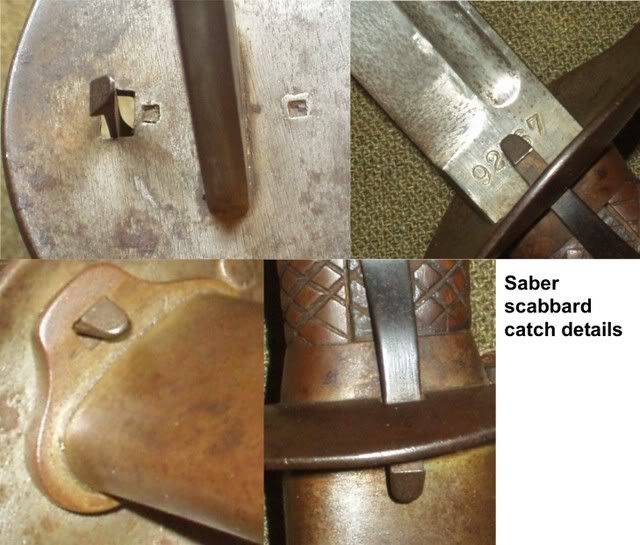 This saber has a unique or at least seldom seen feature, an integral catch that holds the saber in the scabbard but can be instantly released by the index finger as the saber is drawn. Simple and absolutely effective. I've included a photo of several angles of the catch. This is one of my favorite features of this saber.
This saber has a unique or at least seldom seen feature, an integral catch that holds the saber in the scabbard but can be instantly released by the index finger as the saber is drawn. Simple and absolutely effective. I've included a photo of several angles of the catch. This is one of my favorite features of this saber.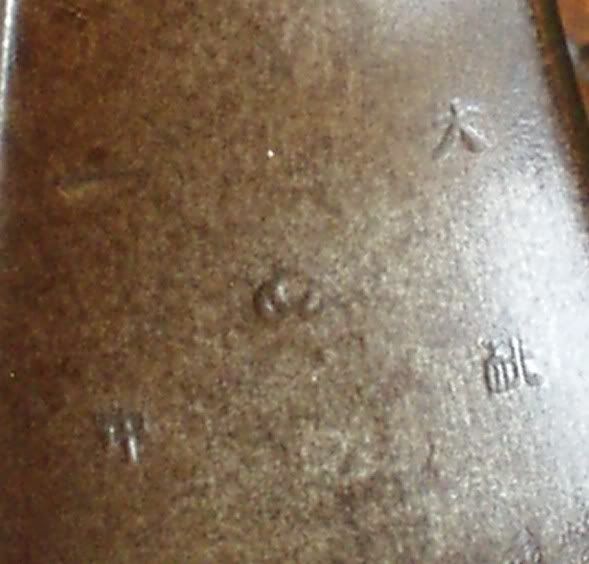 |
| Guard Marks |
These Japanese sabers, introduced in the late 19th Century, have arsenal/machine made blades with serial numbers on the ricasso and will commonly have arsenal stamps on the guard. The hilt back strap on Type 32 model (such as this one), introduced in 1899 and produced until 1945, is checkered steel (commonly blackened). The wood grips are also checkered. There is a leather finger loop on the inside of the guard. The blades have a long, wide fuller running the total length of the blade. The scabbards are steel with a single suspension ring. These are commonly mislabeled as 1886 cavalry sabers. The type 32 replaced the earlier enlisted men's swords and the brass hilt Type 25 Cavalry & NCO sword. There are two lengths, the longer 33" bladed sword being for Cavalry NCOs and enlisted men while the shorter 30.5" bladed sword was for other branch NCOs. This has the shorter blade.
 |
| As it should be... |
These are using swords/sabers not the dress items one often sees from about this period in Europe. During the Russo-Japanese war, battles were fought almost entirely with sword and lance backed up by artillery. Amazing but apparently both sides needed to conserve ammunition! Here's a pic of a cavalry officer of the period.
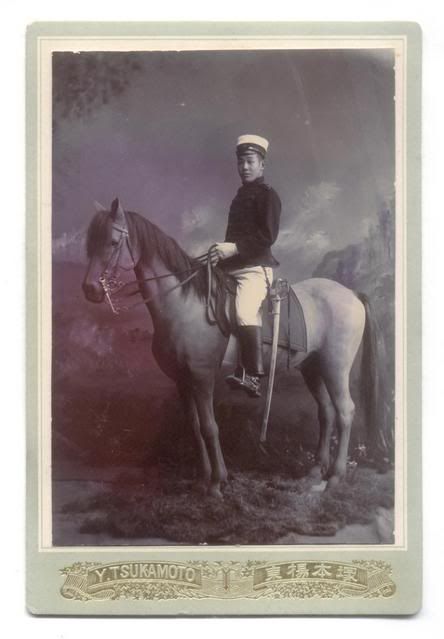
Links:
- Russo-Japanese War Research Society
- Notes on the Russo-Japanese War
-
Thursday, March 22, 2007
"Uncle" Dave's Fox Sterlingworth

"Uncle" Dave (as he was called by my dad) was Grandpa's brother-in-law. But it seems that he was the gunniest of the "family" before me. He must have been because he didn't have much but he spent his money on things like swords (a "wristbreaker" from Bannermans), a Remington Model 8 (new!) and this Fox Sterlingworth (also bought new). Now my dad knew Uncle Dave but he never told me who Uncle Dave was and I had to discover that for myself!
Uncle Dave must have really liked the gun because at some point he installed the rubber recoil pad. It seems from this gun and the Remington that he was wont to do such things but wasn't all that good at it. In any case, we know he took it hunting because before he died he got some snow in the right barrel and split the barrel with his next shot at a bunny or partridge (grouse). He didn't try that repair himself but sent the gun back to the manufacturer with instructions to have the barrel replaced with one with an improved cylinder choke. So it is today, a 12 ga. gun with 28 inch barrels choked IC and Full. Pretty cool and useful in the field.
When he died the gun went to my Grandfather. I think Dave and his wife had no children and so didn't have any other immediate family to whom to pass his stuff. When Grandpa died the guns went to Dad and then to me. This is a great gun. I know that Grandpa used it to hunt deer near Cooperstown, NY and was successful at least once. Dad and I used it to hunt quail and it was the bees knees as it could take them up close or a bit out and going away and was a good fit for me and tolerable for Dad. I can't say how much game Uncle Davee took with it and was never regaled with stories of his exploits. I don't know why, but nobody in the family talked about him much. I did get the idea that he was considered a bit of a ne'er do well and the guns and such were just more evidence of that. I hope my family won't forget me as I imagine I'm a lot like he was! In any case, Dad sure would get a grin when he did mention him.
The Fox Sterlingworth was the entry level grade double and is the most common of all the Fox guns. A.H. Fox started producing shotguns in 1896 working for Fox Gun Company and later Baltimore Gun company before starting A. H. Fox & Company in 1903. In 1930 Savage Arms purchased Fox and began producing guns up till 1942. The Fox shotguns are of very fine quality and compared to the LC Smith, and lower grade Parkers.
Now for the photos.
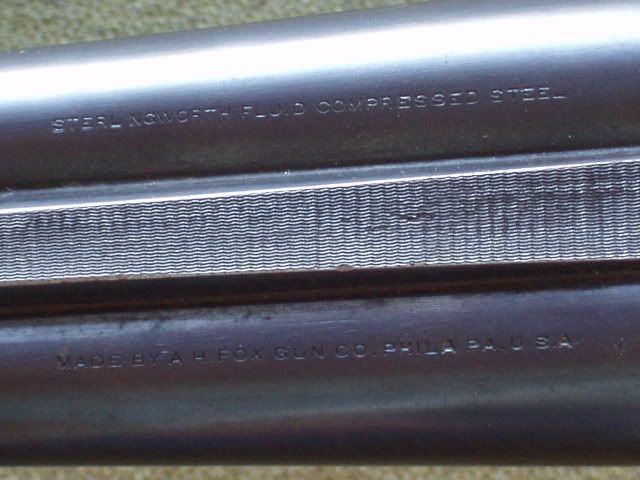 Interestingly, the right barrel is stamped, "STERLNGWORTH FLUID COMPRESSED STEEL" omitting the "I". However, this is the barrel that was replaced so I don't know if that has anything at all to do with it. The left barrel is stamped "MADE BY A.H. FOX GUN CO. PHILA. PA. U.S.A." So this gun uses the patented Sterlingworth steel barrels. I really like the fine knurling on the solid rib which is raised for part of it's length. There is only a front bead sight. There is some slight pitting and finish wear where one would grasp the barrels when shooting. There is also a small dent about 2" back from the muzzle. Nothing to worry about though you can see it. Both the under and top ribs are firmly affixed and the barrels "ring" well.
Interestingly, the right barrel is stamped, "STERLNGWORTH FLUID COMPRESSED STEEL" omitting the "I". However, this is the barrel that was replaced so I don't know if that has anything at all to do with it. The left barrel is stamped "MADE BY A.H. FOX GUN CO. PHILA. PA. U.S.A." So this gun uses the patented Sterlingworth steel barrels. I really like the fine knurling on the solid rib which is raised for part of it's length. There is only a front bead sight. There is some slight pitting and finish wear where one would grasp the barrels when shooting. There is also a small dent about 2" back from the muzzle. Nothing to worry about though you can see it. Both the under and top ribs are firmly affixed and the barrels "ring" well.As you can see the underside of the barrels at the breach are marked with the firearm serial number. This gun has extractors only and they are shown extended, not what I usually do but that is where they were when I snapped the photo! What you can't see so well in the photo is the oval mark under the right barrel or just below the lump in the photo. That is the Fox proof mark showing the barrels have passed the manufacturer's proof test. I have no idea what caused the large circular marks on the flat. There is nothing on the gun that I can see (or as you can see in the photo of the watertable) that could cause this mark. This is yet another mystery of Uncle Dave's gun.
The watertable is also marked with the firearm serial number. Of more interest to some are the patent markings on the left side of the watertable.
"PAT'D DEC 2, 1902
AUG.6.1904 - AUG.1.1905OCT.17.1905 - JAN.16.1906"
The only other markings on the gun are "MODEL 1911" and the firearm serial on the forearm iron. I had thought this gun was made in 1910 according to certain references but why then would it be marked Model 1911 UNLESS the forearm was replaced when the barrels were repaired. It makes sense to me that the forearm was damaged when the barrel split due to the bore obstruction and had to be replaced with a new forearm iron as well. Very interesting, and perhaps, another mystery!
Wednesday, March 21, 2007
Everything Here for EGW Firing Pin Stop Test
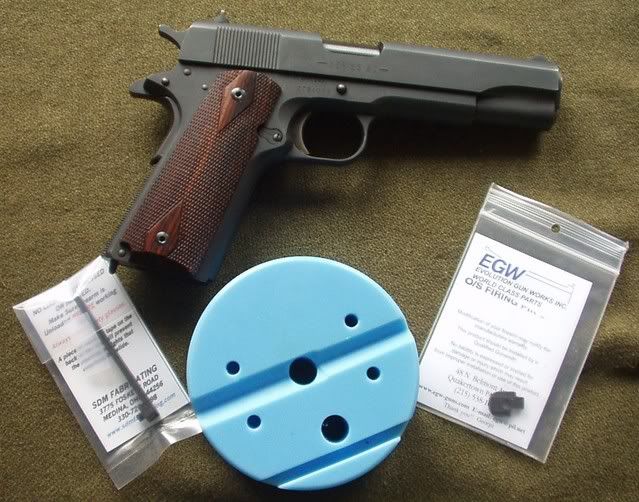 The firing pin stop from EGW and the SDM firing pin stop tool both arrived in today's mail. Shown with the Brownells pistol bench block and my 1991A1, everything is ready to go to fit the EGW FPS to the 1991A1. The stone(s) are downstairs in the tool chest waiting for me to have the free time to sit down and do this right. I'm excited!
The firing pin stop from EGW and the SDM firing pin stop tool both arrived in today's mail. Shown with the Brownells pistol bench block and my 1991A1, everything is ready to go to fit the EGW FPS to the 1991A1. The stone(s) are downstairs in the tool chest waiting for me to have the free time to sit down and do this right. I'm excited!As I mentioned earlier, this should provide some real performance benefits for the gun. I'll be doing a side by side comparison of the pistol's performance with the two FPS and no other changes.
Thanks again to OD, Tuner, Xavier and the gang.
 Now, here is a pic of both FPS on the bench block. Aside from the tight fit, you can easily see the major difference in the two FPS.
Now, here is a pic of both FPS on the bench block. Aside from the tight fit, you can easily see the major difference in the two FPS.
Tuesday, March 20, 2007
More Knives, Knives, Knives...
Yep, there are more. Are you surprised? And there are more after these as well...
 To begin where I left off, this Gerber "military" blade was purchased in 1985 and was used in my military duties. Again mostly to open MREs but on one occasion to surprise somebody who wasn't where they were supposed to be and was messing with my gear as I "slept". All that ceased and nobody in my squad was bothered except for the private who was supposed to be awake and on guard. He always did a good job after that.
To begin where I left off, this Gerber "military" blade was purchased in 1985 and was used in my military duties. Again mostly to open MREs but on one occasion to surprise somebody who wasn't where they were supposed to be and was messing with my gear as I "slept". All that ceased and nobody in my squad was bothered except for the private who was supposed to be awake and on guard. He always did a good job after that.
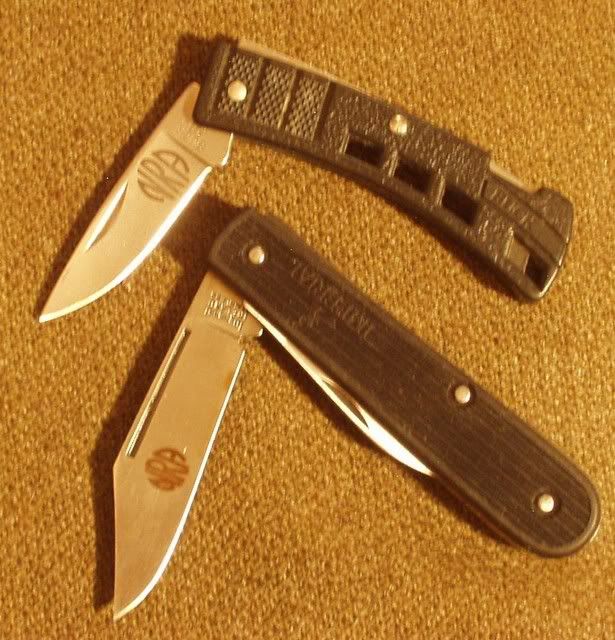 These "NRA" knives were given as promotional items (I would have renewed my membership anyway) for joining or extending membership in the NRA. The top one is a Buck and the bottom one is an Imperial. Both are serviceable for what they are but the blades are no longer than 2" and so aren't quite my cup of tea. They've been in the box since I got them. No, that's not right. I carried the Buck a couple of times to church or something like that. The Imperial, bottom, knife is actually more useful with a longer main blade and a spear point second blade. Ialways use the main blade for everyday tasks and save the little spear points so tht they'll be sharp enough to cut out slivers and such. Both knives are mostly plastic and very light.
These "NRA" knives were given as promotional items (I would have renewed my membership anyway) for joining or extending membership in the NRA. The top one is a Buck and the bottom one is an Imperial. Both are serviceable for what they are but the blades are no longer than 2" and so aren't quite my cup of tea. They've been in the box since I got them. No, that's not right. I carried the Buck a couple of times to church or something like that. The Imperial, bottom, knife is actually more useful with a longer main blade and a spear point second blade. Ialways use the main blade for everyday tasks and save the little spear points so tht they'll be sharp enough to cut out slivers and such. Both knives are mostly plastic and very light.
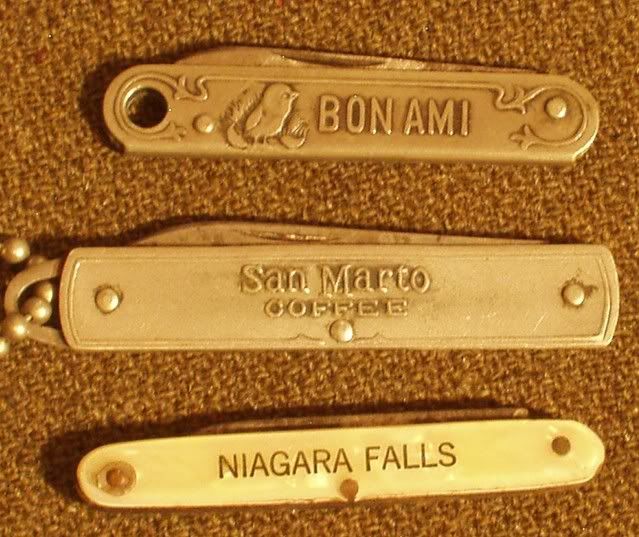 I never used these promotional or advertising premium knives. I found them in Grandpa's junk box when I got it after he died. Interesting stuff. I like that they gave knives as promotional items back then. Now, they'd be sued or worse yet, some kid would take these cute things to school and be expelled for having a "weapon". Might I say that zero tolerance is just an easy out for people too stupid to fairly apply reason to individual cases. Of course I can, at least now.
I never used these promotional or advertising premium knives. I found them in Grandpa's junk box when I got it after he died. Interesting stuff. I like that they gave knives as promotional items back then. Now, they'd be sued or worse yet, some kid would take these cute things to school and be expelled for having a "weapon". Might I say that zero tolerance is just an easy out for people too stupid to fairly apply reason to individual cases. Of course I can, at least now.
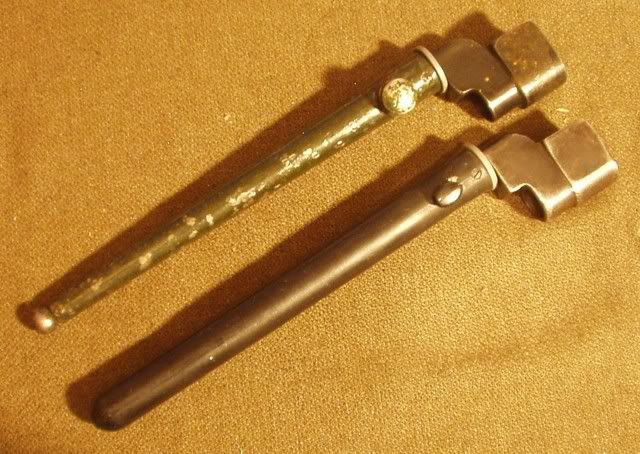 These are two spike bayonets for my Enfield No. 4 MKI rifles. The blade forms are nearly identical but the markings are different. There were lots of variations on the theme for these rifles. The big thing here are the two different scabbards. The bottom scabbard is plastic. I like these bayonets. All business and not too heavy. The US Army has that crappy M9 bayonet now. Those things weigh too much and do too little. We had a lot of them break on the bayonet assault range whereas the old, "obsolete", M7s would just bend and could be bent back to serviceability. Yep, I got these to use on my rifles. It is good to have a complete stand of arms.
These are two spike bayonets for my Enfield No. 4 MKI rifles. The blade forms are nearly identical but the markings are different. There were lots of variations on the theme for these rifles. The big thing here are the two different scabbards. The bottom scabbard is plastic. I like these bayonets. All business and not too heavy. The US Army has that crappy M9 bayonet now. Those things weigh too much and do too little. We had a lot of them break on the bayonet assault range whereas the old, "obsolete", M7s would just bend and could be bent back to serviceability. Yep, I got these to use on my rifles. It is good to have a complete stand of arms.
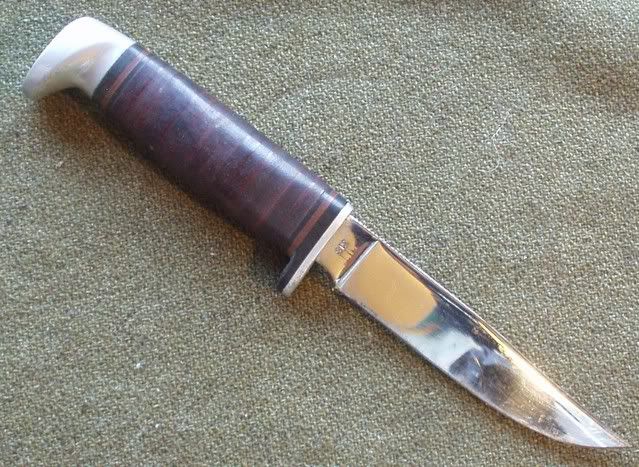 This Case is the second knife I bought for myself. I had to return the first. Mom and Dad made me return the first one which I bought at Town and Country in Harrisonburg, VA. I don't know why, but they didn't care about pocket knives, aka folders, but they about threw a hissy fit when I brought this home. I don't know why, I had a sword in my room (more about that later, I told you there were more blades to discuss). Anyway, I had to wait a while before I could buy this knife so that I could go hunting. I don't think it was more than a year or two later that I started hunting. I guess Mom and Dad figured if I had a gun that having a "sheath knife" was no big deal. Funny, huh?
This Case is the second knife I bought for myself. I had to return the first. Mom and Dad made me return the first one which I bought at Town and Country in Harrisonburg, VA. I don't know why, but they didn't care about pocket knives, aka folders, but they about threw a hissy fit when I brought this home. I don't know why, I had a sword in my room (more about that later, I told you there were more blades to discuss). Anyway, I had to wait a while before I could buy this knife so that I could go hunting. I don't think it was more than a year or two later that I started hunting. I guess Mom and Dad figured if I had a gun that having a "sheath knife" was no big deal. Funny, huh?
 This little jewel was given me by my good friend, now in heaven, Mike Mays. I've no idea where or how Mike came up with this knife. It is so pretty that I've never made a sheath for it or used it. It is a shame not to but I just was never able to do so. It is unmarked so I don't know who made it or when. It appears to be a stainless steel and the handle is a green laminate of some kind. I think it is a very pretty knife.
This little jewel was given me by my good friend, now in heaven, Mike Mays. I've no idea where or how Mike came up with this knife. It is so pretty that I've never made a sheath for it or used it. It is a shame not to but I just was never able to do so. It is unmarked so I don't know who made it or when. It appears to be a stainless steel and the handle is a green laminate of some kind. I think it is a very pretty knife.
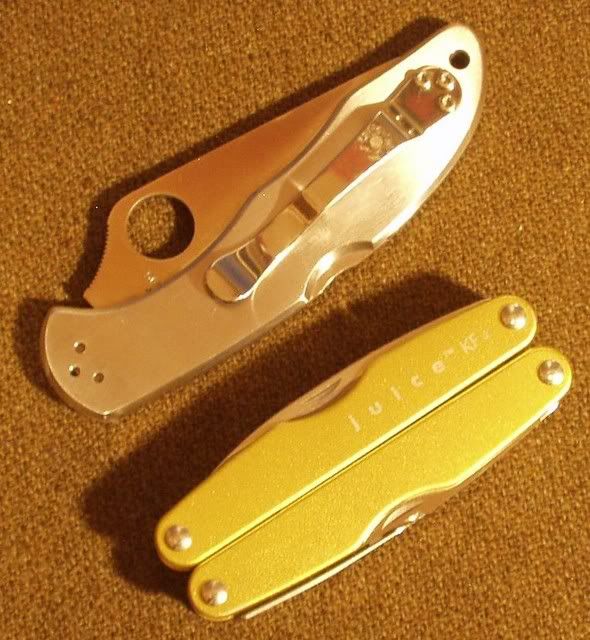 Last, but not the least, in this installment are the two knives I carry every day. The first is the previously mentioned Spyderco Delica that I bought, on sale, to replace another Delica that I lost at the movie theater. Apparently, I just discovered, I sat down in the seat and the clip snagged the drink holder which shucked it right out of my pocket as pretty as you please. Since the old knife was the reinforced fiberglass handle type and black, I couldn't see it there in the darkened theater. Makes me feel pretty stupid.
Last, but not the least, in this installment are the two knives I carry every day. The first is the previously mentioned Spyderco Delica that I bought, on sale, to replace another Delica that I lost at the movie theater. Apparently, I just discovered, I sat down in the seat and the clip snagged the drink holder which shucked it right out of my pocket as pretty as you please. Since the old knife was the reinforced fiberglass handle type and black, I couldn't see it there in the darkened theater. Makes me feel pretty stupid.
The other is one of the Leatherman Juice series. This is the KF4. I've had several Leathermen (dang I'll have to hunt those up, too!) but this is about an ideal balance for pocket carry and useability. Not only does it have blades (serrated and plain) but file, screwdrivers (phillips and blade), saw, pliers, wirecutter and awl. Since Tim Leatherman came out with tools I've had one with me most everyday. I use them, too. Great idea.
There will be more, I've got swords, multi-tools and more knives...
 To begin where I left off, this Gerber "military" blade was purchased in 1985 and was used in my military duties. Again mostly to open MREs but on one occasion to surprise somebody who wasn't where they were supposed to be and was messing with my gear as I "slept". All that ceased and nobody in my squad was bothered except for the private who was supposed to be awake and on guard. He always did a good job after that.
To begin where I left off, this Gerber "military" blade was purchased in 1985 and was used in my military duties. Again mostly to open MREs but on one occasion to surprise somebody who wasn't where they were supposed to be and was messing with my gear as I "slept". All that ceased and nobody in my squad was bothered except for the private who was supposed to be awake and on guard. He always did a good job after that.  These "NRA" knives were given as promotional items (I would have renewed my membership anyway) for joining or extending membership in the NRA. The top one is a Buck and the bottom one is an Imperial. Both are serviceable for what they are but the blades are no longer than 2" and so aren't quite my cup of tea. They've been in the box since I got them. No, that's not right. I carried the Buck a couple of times to church or something like that. The Imperial, bottom, knife is actually more useful with a longer main blade and a spear point second blade. Ialways use the main blade for everyday tasks and save the little spear points so tht they'll be sharp enough to cut out slivers and such. Both knives are mostly plastic and very light.
These "NRA" knives were given as promotional items (I would have renewed my membership anyway) for joining or extending membership in the NRA. The top one is a Buck and the bottom one is an Imperial. Both are serviceable for what they are but the blades are no longer than 2" and so aren't quite my cup of tea. They've been in the box since I got them. No, that's not right. I carried the Buck a couple of times to church or something like that. The Imperial, bottom, knife is actually more useful with a longer main blade and a spear point second blade. Ialways use the main blade for everyday tasks and save the little spear points so tht they'll be sharp enough to cut out slivers and such. Both knives are mostly plastic and very light. I never used these promotional or advertising premium knives. I found them in Grandpa's junk box when I got it after he died. Interesting stuff. I like that they gave knives as promotional items back then. Now, they'd be sued or worse yet, some kid would take these cute things to school and be expelled for having a "weapon". Might I say that zero tolerance is just an easy out for people too stupid to fairly apply reason to individual cases. Of course I can, at least now.
I never used these promotional or advertising premium knives. I found them in Grandpa's junk box when I got it after he died. Interesting stuff. I like that they gave knives as promotional items back then. Now, they'd be sued or worse yet, some kid would take these cute things to school and be expelled for having a "weapon". Might I say that zero tolerance is just an easy out for people too stupid to fairly apply reason to individual cases. Of course I can, at least now.  These are two spike bayonets for my Enfield No. 4 MKI rifles. The blade forms are nearly identical but the markings are different. There were lots of variations on the theme for these rifles. The big thing here are the two different scabbards. The bottom scabbard is plastic. I like these bayonets. All business and not too heavy. The US Army has that crappy M9 bayonet now. Those things weigh too much and do too little. We had a lot of them break on the bayonet assault range whereas the old, "obsolete", M7s would just bend and could be bent back to serviceability. Yep, I got these to use on my rifles. It is good to have a complete stand of arms.
These are two spike bayonets for my Enfield No. 4 MKI rifles. The blade forms are nearly identical but the markings are different. There were lots of variations on the theme for these rifles. The big thing here are the two different scabbards. The bottom scabbard is plastic. I like these bayonets. All business and not too heavy. The US Army has that crappy M9 bayonet now. Those things weigh too much and do too little. We had a lot of them break on the bayonet assault range whereas the old, "obsolete", M7s would just bend and could be bent back to serviceability. Yep, I got these to use on my rifles. It is good to have a complete stand of arms.  This Case is the second knife I bought for myself. I had to return the first. Mom and Dad made me return the first one which I bought at Town and Country in Harrisonburg, VA. I don't know why, but they didn't care about pocket knives, aka folders, but they about threw a hissy fit when I brought this home. I don't know why, I had a sword in my room (more about that later, I told you there were more blades to discuss). Anyway, I had to wait a while before I could buy this knife so that I could go hunting. I don't think it was more than a year or two later that I started hunting. I guess Mom and Dad figured if I had a gun that having a "sheath knife" was no big deal. Funny, huh?
This Case is the second knife I bought for myself. I had to return the first. Mom and Dad made me return the first one which I bought at Town and Country in Harrisonburg, VA. I don't know why, but they didn't care about pocket knives, aka folders, but they about threw a hissy fit when I brought this home. I don't know why, I had a sword in my room (more about that later, I told you there were more blades to discuss). Anyway, I had to wait a while before I could buy this knife so that I could go hunting. I don't think it was more than a year or two later that I started hunting. I guess Mom and Dad figured if I had a gun that having a "sheath knife" was no big deal. Funny, huh? This little jewel was given me by my good friend, now in heaven, Mike Mays. I've no idea where or how Mike came up with this knife. It is so pretty that I've never made a sheath for it or used it. It is a shame not to but I just was never able to do so. It is unmarked so I don't know who made it or when. It appears to be a stainless steel and the handle is a green laminate of some kind. I think it is a very pretty knife.
This little jewel was given me by my good friend, now in heaven, Mike Mays. I've no idea where or how Mike came up with this knife. It is so pretty that I've never made a sheath for it or used it. It is a shame not to but I just was never able to do so. It is unmarked so I don't know who made it or when. It appears to be a stainless steel and the handle is a green laminate of some kind. I think it is a very pretty knife.  Last, but not the least, in this installment are the two knives I carry every day. The first is the previously mentioned Spyderco Delica that I bought, on sale, to replace another Delica that I lost at the movie theater. Apparently, I just discovered, I sat down in the seat and the clip snagged the drink holder which shucked it right out of my pocket as pretty as you please. Since the old knife was the reinforced fiberglass handle type and black, I couldn't see it there in the darkened theater. Makes me feel pretty stupid.
Last, but not the least, in this installment are the two knives I carry every day. The first is the previously mentioned Spyderco Delica that I bought, on sale, to replace another Delica that I lost at the movie theater. Apparently, I just discovered, I sat down in the seat and the clip snagged the drink holder which shucked it right out of my pocket as pretty as you please. Since the old knife was the reinforced fiberglass handle type and black, I couldn't see it there in the darkened theater. Makes me feel pretty stupid.The other is one of the Leatherman Juice series. This is the KF4. I've had several Leathermen (dang I'll have to hunt those up, too!) but this is about an ideal balance for pocket carry and useability. Not only does it have blades (serrated and plain) but file, screwdrivers (phillips and blade), saw, pliers, wirecutter and awl. Since Tim Leatherman came out with tools I've had one with me most everyday. I use them, too. Great idea.
There will be more, I've got swords, multi-tools and more knives...
Knives, Knives, Knives
Boy oh boy. I had no idea. Oh, I knew I had this knife or that knife that I had them here and there and so forth. But I never knew I had so darn many knives that I'd used and some I hadn't. A couple are family knives, heirloom pieces I never take to the field, some are souvenir pieces that came from who knows where, and many I've used over the years as I searced for a good knife for daily carry and as the industry has evolved over the last 30+ years.
This Remington was made from 1933-1940, and is an RH(Remington Hunting)-32. Remington actually had their own factory from 1919-1940, in 1933 Dupont bought Rem. later it was sold to Pal when Remington decided to concentrate on their WWII contracts. It is indeed marked "RC-32" on the right ricasso and also has the "Dupont" in a oval trademark on the left ricasso. I don't really know much about this knife but I had thought that Dad may have bought this knife new sometime between 1947 and 1955. I think (not certain) that he had it from at least the time I was born. It is possible that he bought it used or that it was a gift at some time.
This second heirloom knife is somewhat of a mystery. A very early leather & stag Marble's Ideal pattern, I believe that it was Uncle Dave Fancher's and passed to Grandpa. It passed to Dad when Grandpa died. Grandpa kept it in his garage in the original old pouch type sheath and dad replaced that sheath when he got the knife. I need to carefully clean it up to read the markings which are on the left ricasso only. There in a 3-line mark it is marked "M.S.A. CO" over "Gladstone" over "MICH U.S.A." (which is pretty faint in areas).
These two Buck 112s are sort of the beginning of the knife industry we know today. They were "cutting edge" when I bought the top one while at the Presidio of Monterey in 1973. I found the other on the street just below the barracks one day and gave it to Dad when I came home for Christmas 1974. He used it and it was on the workbench when he died. These are good solid knives and have given good service over many years.
I got this knife in 1974. A Gerber Sportsman II, I bought the knife on Cannery Row in Monterey, CA while I was stationed at the Presidio of Monterey and attending the Defense Language School. Regulations and laws were such then that this was an acceptable knife to carry daily. I liked it because it was thinner than the Buck 112. I carried it for quite a while until a fellow soldier borrowed it to cut up some cardboard boxes and somehow broke the blade. I sent the knife to Gerber and they replaced the blade. I put the knife away when it came back and and haven't used it since. That is the original box.
This is a parachutist's knife. I've got two. Can't remember exactly where they came from but I must have been issued these and never used them but packed them up because I had my own knife. No, I was never a parachutist. Gives me the willies just to think of having to jump out of a perfectly good airplane. I hate heights but do what I've got to. Anyway, these are interesting as they are spring opening assisted. Made by Camillus (now defunct), these will probably appreciate over time.
This standard US military 4-bladed utility knife was issue about 1986 and I carried it for several years in lieu of the Gerber. I have accumulated several of these knives but this is the earliest dated being 1979. This is also a Camillus. At $15 for many years, these are inexpensive but pretty good knives for daily use. One can do much much worse than to have and use one of these plain knives.
Please correct me if I'm wrong but I think that this is a Gerber LST II. I bought the knife while at PLDC at Camp Beauregard, Pineville, LA in 1986 to congratulate myself for graduating (I was distinguished honor grad!). I carried that knife on and off but particularly when in civilian clothes as it is very small, thin and light but has a good blade that holds an edge well. It has opened a bunch of packages! I think that this series was one of the first with the reinforced fiberglass handles as a fully functional part of the knife. There isn't much more to this knife than the blade, spring and handles.
This is the Spyderco Endura I carried for about 6-7 years. I mis-spoke when I said it was a combo edge. As you can see it is a full serrated edge. This was a just in case knife and I seldom used it to cut anything but carried it clipped into the top of the button tube on by BDU jacket. I felt that if I could I might be able to get to this knife even with my hands up. This was because some ne'er-do-wells had apparently, according to local law enforcement, thought of targeting my arms room. The blade length is too long to carry concealed in Virginia though. So, this knife now stays in the box.
I like the Swiss Army knives. This is just 3 of those that I have. I have 5 I've never used (or even opened the packages). I just get them. The first I ever got and carried was that GH Rose promotional knife. A driver for Rose gave me that knife when I was working for the Combat Development Command Mission Account at FT Hunter-Liggett, CA in 1976. I used that knife for several years and it carries some fond memories of the folks at the Mission Account. Sergeants Dickie and Napper were good mentors for my professional development. There were many others working there who were good people. All of us having families with other interests we didn't socialize much. The others I bought and carried until I found another configuration to try. These are quality knives at reasonable prices.
This is a Gerber Guardian. I bought this knife during my tactical phase. OK, I can laugh about it now but at the time everybody had a "tactical" knife on their web gear. This thing has been lashed hither and yon and carried clipped to the belt under BDUs. However, it was used mostly to open MREs. The camo design was almost a requirement for a while then it seemed to switch to black. Interesting how the fashions change and, indeed, that is what this is, a fashion statement. There are much better knife designs.
I have more but those will have to wait until later.
 |
| RH-32 |
 |
| Marble's Ideal |
 |
| Buck 112s |
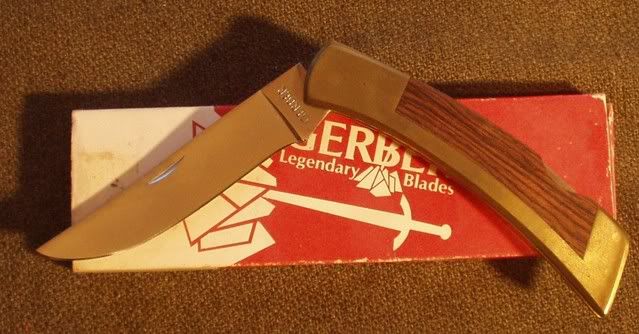 |
| Gerber Sportsman II |
 |
| Parachutist's knife |
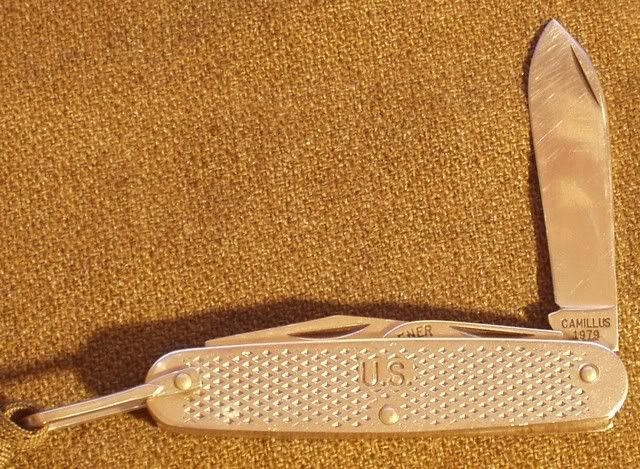 |
| Military 4-bladed utility |
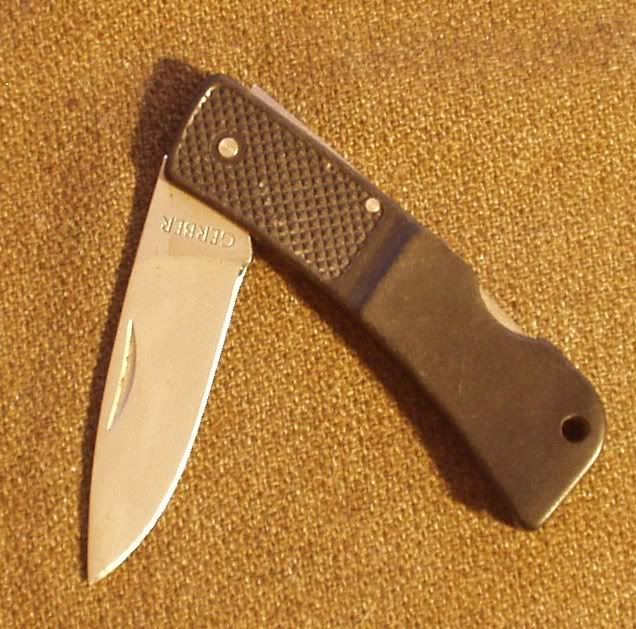 |
| Gerber LST II |
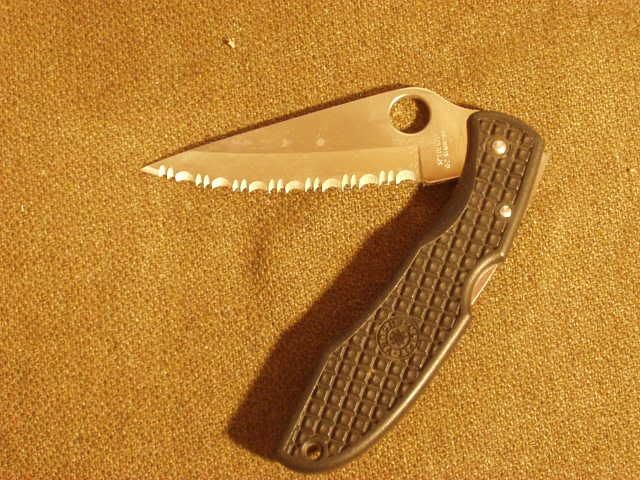 |
| Spyderco Endura |
 |
| Assorted Swiss Army Knives |
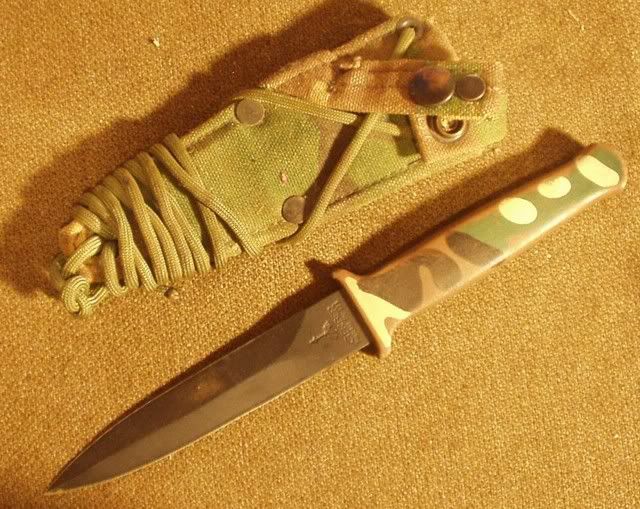 |
| Gerber Guardian |
I have more but those will have to wait until later.
Monday, March 19, 2007
An Interesting Thing..
I had an interesting thing happen to me this past weekend when my wife and went to see 300. As I sat down the clip on my Spyderco Delica snagged the cup holder in the arm of the seat and neatly deposited itself on the cup holder. Ticked me off. I bet this is how I lost the other Delica...
Webley Tempest
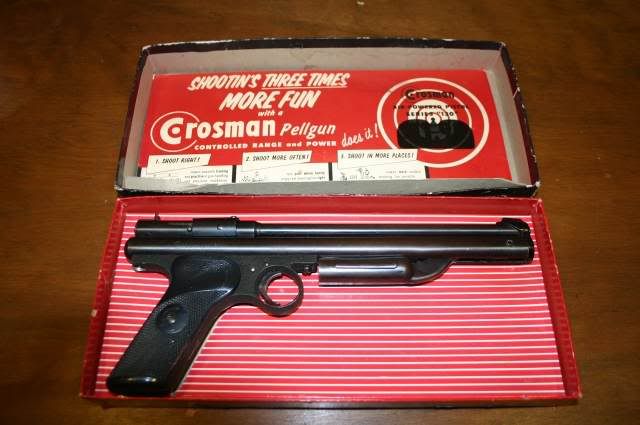 While stationed in the Republic of Korea, I was often bored to tears. My children were small and I spent long hours on duty but not really doing anything. Lots of time to think you could say. Mostly I thought about shooting and read about shooting. I really felt that an air pistol would help me with my handgun shooting and cheaply (a real consideration). Of course I had some experience with the Crossman 130, a pump type, air pistol (the later 1377 is shown here) which I'd flat worn out! A spring air gun seemed the way to go but I wanted something more compact than the target type guns more generally available.
While stationed in the Republic of Korea, I was often bored to tears. My children were small and I spent long hours on duty but not really doing anything. Lots of time to think you could say. Mostly I thought about shooting and read about shooting. I really felt that an air pistol would help me with my handgun shooting and cheaply (a real consideration). Of course I had some experience with the Crossman 130, a pump type, air pistol (the later 1377 is shown here) which I'd flat worn out! A spring air gun seemed the way to go but I wanted something more compact than the target type guns more generally available.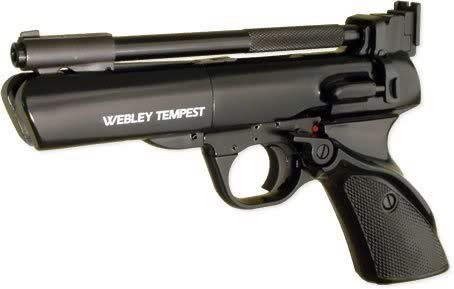 What seemed to work for me was the Webley Tempest
What seemed to work for me was the Webley TempestThe latest version of the original barrel over cylinder design, that has made Webley pistols world famous. Rugged and compact the Webley Tempest features an adjustable rear sight and adjustable single stage trigger. With its authentic recoil the Tempest is ideal for general target shooting and firearm training. Available in either .177 or .22 calibre.This has worked out pretty well for me since I bought the gun in 1980. I've shot a lot of pellets through the pistol without any serious maintenance and I think it has helped my shooting. I've even taken a couple of squirrels with it!
The trigger on the gun is a bit rough. It does take some adaptation but can be slightly improved. I've never bothered and think that either the trigger or I have gotten better over the years. The sights are simple as are the adjustments and these can give some moments of frustration when zeroing the pistol. However, mine has been durable and enjoyable and the compact design lends to a go anywhere practicability.
 I have found that, for hunting, the pellet choice is critical. I've settled on the Beeman Silver Jet as the pest compromise of weight and penetration (critical in the hunting application) as the best hunting pellet. However, many different pellets can be used for shooting enjoyment. The relatively new Gamo PBR pellet might both increase velocity and penetration.
I have found that, for hunting, the pellet choice is critical. I've settled on the Beeman Silver Jet as the pest compromise of weight and penetration (critical in the hunting application) as the best hunting pellet. However, many different pellets can be used for shooting enjoyment. The relatively new Gamo PBR pellet might both increase velocity and penetration.Links:
- The Webley Tempest
- The Webley Tempest by Todd Cooper
Saturday, March 17, 2007
Lanyard Loop Main Spring Housing for 1991A1
 The Smith and Alexander main spring housing with lanyard loop arrived from Brownells TODAY! Already installed. Mine is the FLAT checkered. One can also get the flat smooth as well as the arched checkered. The additional weight of the steel vs nylon factory unit plus the quality of the checkered vs the grooved MSH makes it a joy even sans lanyard loop but the loop, well wooo-hooo!
The Smith and Alexander main spring housing with lanyard loop arrived from Brownells TODAY! Already installed. Mine is the FLAT checkered. One can also get the flat smooth as well as the arched checkered. The additional weight of the steel vs nylon factory unit plus the quality of the checkered vs the grooved MSH makes it a joy even sans lanyard loop but the loop, well wooo-hooo! I'm glad I got the bench block as well (several months ago). Sure made disassembly and assembly a snap. I was done in about 4 minutes including the walk downstairs!
Eldest Daughter's Birthday Today
 Eldest daughter turns 31 today. She might be a STEP-daughter but that isn't how I feel about her. Great "kid" and I'm very proud of her. She'll be down next weekend for the March birthdays celebration.
Eldest daughter turns 31 today. She might be a STEP-daughter but that isn't how I feel about her. Great "kid" and I'm very proud of her. She'll be down next weekend for the March birthdays celebration. The whole family gets together for spring celebration sometime around this time in March as she and I have our birthdays on the 17th and 23rd respectively. Cuts down on the cake and pounds...
We'll likely do a fall celebration as younger daughter, son-in-law, wife and mother all have their birthdays in a 30 day period. Of course the grand kids will each get their own celebration.
Friday, March 16, 2007
Friend's 1902 Rolling Block - Updated
Found out some interesting info about the 1902 Roller. How did I find this out? Well, there's an article in this latest Blackpowder Cartridge News. Serendipitous that is.
First, the rifle is not chambered for the 7x57 Mauser. Like the .30-03 vs the .30-06 cartridge, the rifle is chambered for a slightly different Spanish 7mm Model 93 cartridge (aka 1893 7mm Mauser).
E.g. case length is 2.24" vs 2.235" (older vs newer) and length head to shoulder is 1.71" vs 1.470" (now that is the critical headspace length). Also, Winchester brass has a thinner rim and might work whereas Remington brass might not.
My friend is likely pumped to find this, I know I am.
First, the rifle is not chambered for the 7x57 Mauser. Like the .30-03 vs the .30-06 cartridge, the rifle is chambered for a slightly different Spanish 7mm Model 93 cartridge (aka 1893 7mm Mauser).
E.g. case length is 2.24" vs 2.235" (older vs newer) and length head to shoulder is 1.71" vs 1.470" (now that is the critical headspace length). Also, Winchester brass has a thinner rim and might work whereas Remington brass might not.
My friend is likely pumped to find this, I know I am.
Thursday, March 15, 2007
CHP Database Cached by Google?
The Roanoke Times put up the VA State DHP database, errors, stalking victims, cops and all and then, under a storm of protest, found justification for taking it down, ostensibly permanently. But Google will cache stuff. Did they? How could you find it? I haven't been able to. If you can, write me please.
Wednesday, March 14, 2007
I Ordered one of the EGW Firing Pin Stops
 I've seen this before but a post on Firehand's blog about the "square" bottom 1911 firing pin stop just made me do it. I ordered one from EGW.
I've seen this before but a post on Firehand's blog about the "square" bottom 1911 firing pin stop just made me do it. I ordered one from EGW.I also ordered a flat, checkered main spring housing with lanyard loop for the 1991A1. I need it for my pseudo military kit shown here.
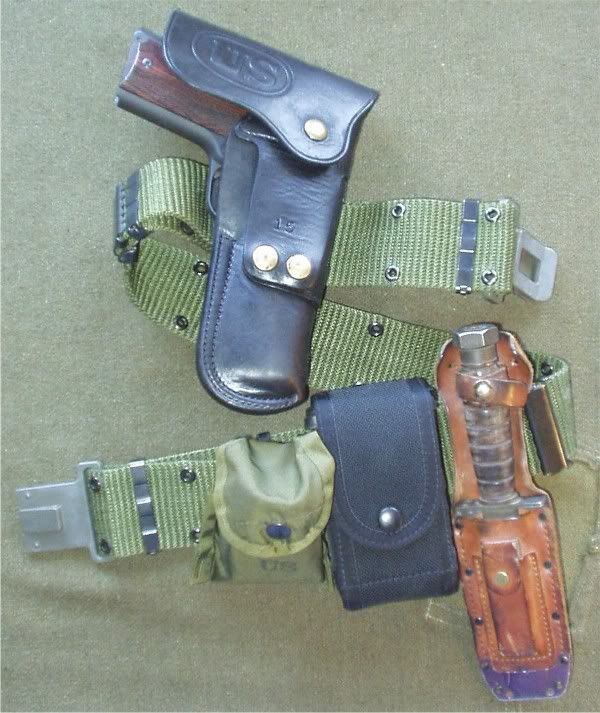
Links: EGW firing pin stop ? Why? (1911Forum.com)
Amazing reduction in recoil with a simple part change - EGW firing pin stop
SDM Firing Pin Stop Tool
Chainsaw Work at Mom's
Did some chainsaw work at Mom's while she stood and knitted. Glad to see her knitting and talking without hesitation. Her meds are working.
Cleaned up the rest of the ice storm damage along the drive way and started trimming the pine plantation trees up to head high so that I can mow under them. Lots more trees to do. This is what it looked like after last years' work as it appears from the entrance to the driveway.
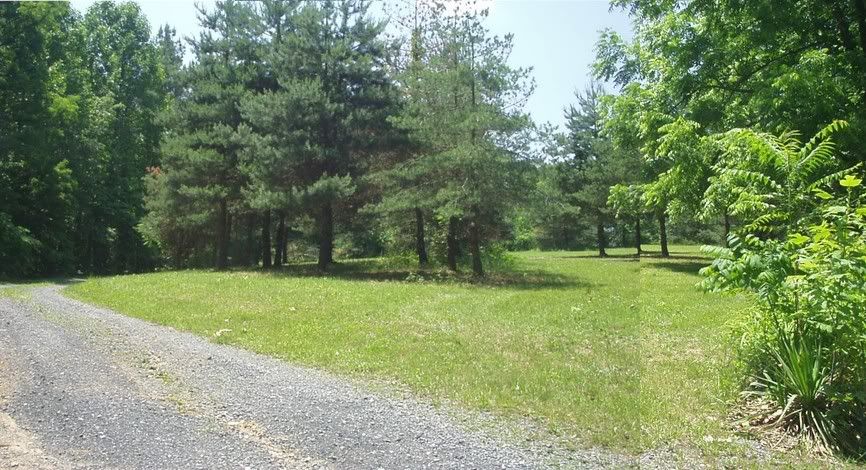
Cleaned up the rest of the ice storm damage along the drive way and started trimming the pine plantation trees up to head high so that I can mow under them. Lots more trees to do. This is what it looked like after last years' work as it appears from the entrance to the driveway.

Spent Time Working on Mom's Place Yesterday
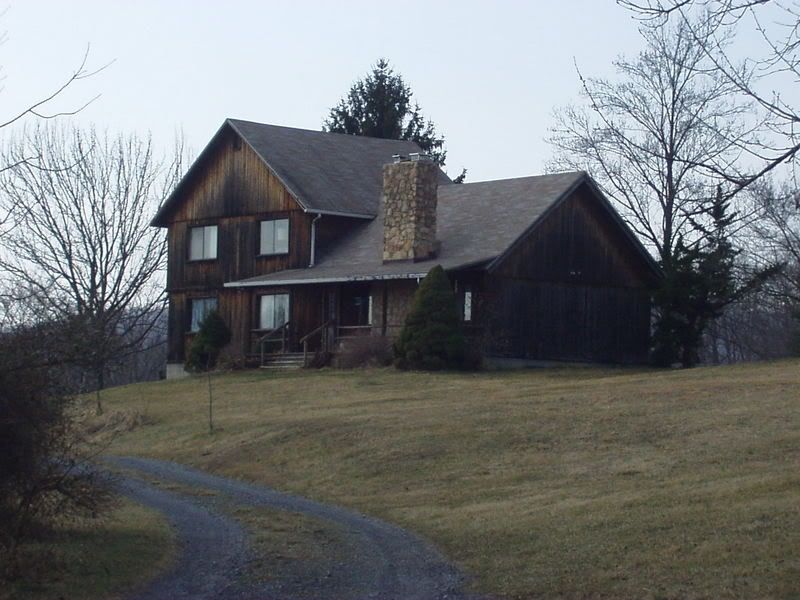 I spent some time working on Mom's place yesterday afternoon. The photos are of the house which is on 16-1/4 acres (more or less). We're trying to maintain the grounds with an eye towards likely later sale. Some of the places in the immediate area of the house and along the driveway were overgrown so I've been clearing that out.
I spent some time working on Mom's place yesterday afternoon. The photos are of the house which is on 16-1/4 acres (more or less). We're trying to maintain the grounds with an eye towards likely later sale. Some of the places in the immediate area of the house and along the driveway were overgrown so I've been clearing that out. I've shown the house after removing the 8-10 foot high and wide landscaping plants. However I still have the stumps and I've been digging these out. Quite a lot of work with mattock, ax, and sometimes, digging bar.
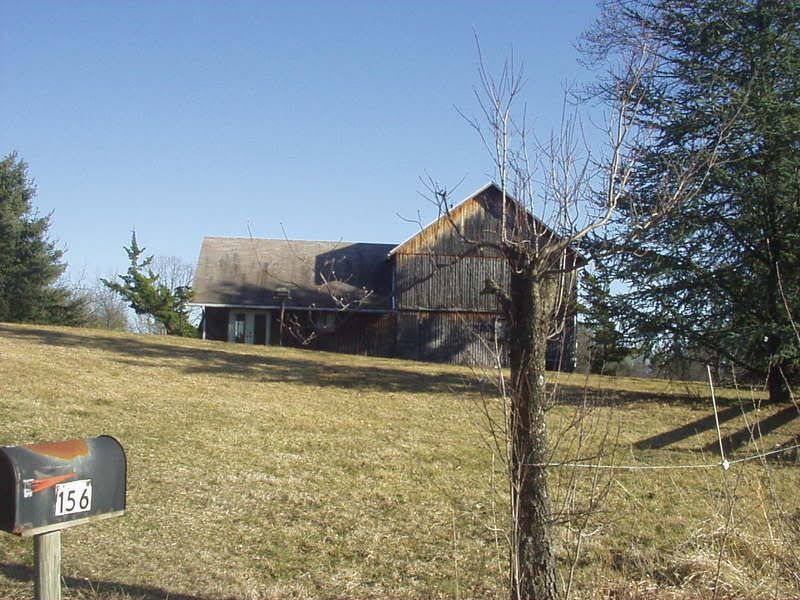 I also have some junk to take to the dump. One piece of that is an old toilet with a cracked tank that I broke up today so that I could more easily lift it into the truck. A side benefit is that the "johnstone" is fun to knap. I hope I'll be able to post a spear point later. I know one thing, this will produce some sharp points. I barely brushed an edge and laid open one finger!
I also have some junk to take to the dump. One piece of that is an old toilet with a cracked tank that I broke up today so that I could more easily lift it into the truck. A side benefit is that the "johnstone" is fun to knap. I hope I'll be able to post a spear point later. I know one thing, this will produce some sharp points. I barely brushed an edge and laid open one finger! It is also about time to start refiring up the old mineral lick. Seemed to do well in keeping deer in the area. I will also feed more agressively so that Mom can see more deer close to the house. That's a treat for her.
Subscribe to:
Comments (Atom)
